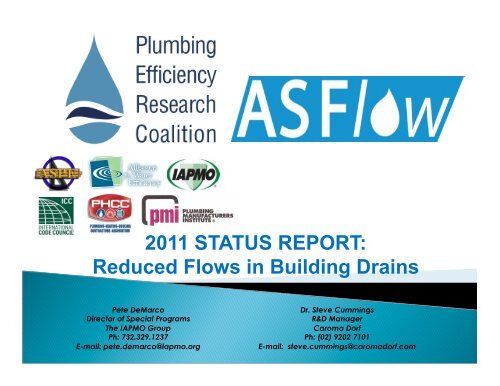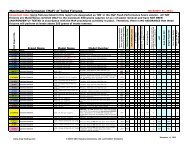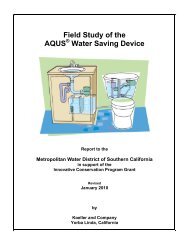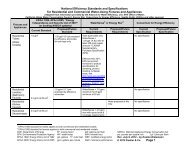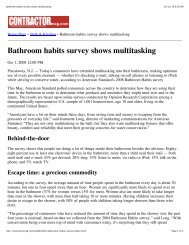October 2011 - (MaP) Testing
October 2011 - (MaP) Testing
October 2011 - (MaP) Testing
Create successful ePaper yourself
Turn your PDF publications into a flip-book with our unique Google optimized e-Paper software.
<strong>2011</strong> STATUS REPORT:<br />
Reduced Flows in Building Drains<br />
Pete DeMarco<br />
Director of Special Programs<br />
The IAPMO Group<br />
Ph: 732.329.1237<br />
E-mail: pete.demarco@iapmo.org<br />
Dr. Steve Cummings<br />
R&D Manager<br />
Caroma Dorf<br />
Ph: (02) 9202 7101<br />
E-mail: steve.cummings@caromadorf.com
The Good News: New water efficient fixtures and<br />
appliances are reducing demand on potable water<br />
The Not-So-Good News: We have some concerns<br />
Health and Safety<br />
Systemic Efficacy<br />
Drainline transport concerns are inhibiting the use<br />
of High Efficiency Toilets<br />
The US EPA is delaying the development of<br />
WaterSense specification for commercial HETs<br />
pending research
ASPE joins PERC in <strong>2011</strong>!<br />
Funding for drainline research has yet to be<br />
received<br />
Scope of proposed research reduced in 2010 to<br />
lower cost<br />
Focus of revised scope:<br />
1. Evaluation of intermittent high volume “flush” to<br />
avoid drainline blockage occurrences<br />
2. Determination of the importance of the design of<br />
the toilet in drainline transport relative to other<br />
plumbing system design considerations
Lab based testing<br />
200 - 300 foot drainline apparatus, location TBD<br />
4 inch diameter pipe (most common, worst case)<br />
System variables: pitch and flush volume<br />
Toilet design variables: percent flush water<br />
training solids and flow rate<br />
Analysis of data will rank significance of these<br />
variables and determine interactions<br />
Intermittent “clearing flush” at 1% and 2%<br />
frequency<br />
Cost using revised scope of work - $170K<br />
Yes, we still need funding!
December 2010: ASFlow and PERC Sign MoU at<br />
EPA HQ<br />
First ever international MoU focusing on plumbing<br />
research<br />
Objective – “…research collaboration...for studying<br />
the sanitary flow and addressing any consequences<br />
of reduced water usage from water conservation<br />
measures, reduction in water usage by plumbing<br />
fixtures, and other drivers to reduce household and<br />
commercial water usage.”
Goals of MoU<br />
Investigate current Australian, US and overseas<br />
research activities to avoid duplication of<br />
research<br />
Review current knowledge on impacts of<br />
reduced flows on sanitary plumbing and<br />
drainage systems<br />
Identify and quantify knowledge gaps<br />
Compare installation and design practices<br />
Communicate with overseas research groups on<br />
research methodologies
Excellent work continues<br />
Down Under<br />
Study on horizontal<br />
junctions completed in<br />
2010 (presented at 2010<br />
WSI)<br />
Results will be basis of<br />
plumbing code revisions<br />
Test Media /<br />
Paper<br />
4 th<br />
Junction<br />
Waste Back<br />
Flow
Excellent work continues Down Under<br />
Toilet paper testing<br />
22 brands of commercially available brands tested<br />
Toilet paper characteristics varied by # of ply, texture, weight
Toilet Paper Media Study – Determination of performance characteristics<br />
No.5<br />
Test Paper Characteristics<br />
Sheet Size: 11x10cm<br />
Ply: 2<br />
Weight (g) of 10 sheets: 3.8g<br />
No.8<br />
Test Paper Characteristics<br />
Sheet Size: 11x10cm<br />
Ply: 1<br />
Weight (g) of 10 sheets: 3.6g<br />
No.12<br />
Test Paper Characteristics<br />
Sheet Size: 11x10cm<br />
Ply: 2<br />
Weight (g) of 10 sheets: 5.1g<br />
Best Performing Poorest Performing Nearest the Average<br />
Size, Ply and Weight
Toilet Paper Media Study – Results<br />
Combination of solids and paper reduce drainline performance
Toilet Paper Media Study – Low Cost Predictive Tests?<br />
Water Absorption Test or Tensile Strength Test Correlation to Drain Line Transport Distance?<br />
Water Absorption Test<br />
Test<br />
samples:<br />
6 Sheets TP<br />
Crumpled as<br />
in <strong>MaP</strong> test<br />
Time until<br />
sample<br />
becomes<br />
saturated<br />
Count # of<br />
washers at<br />
failure
Toilet Paper Media Study – Low Cost Predictive Tests?<br />
Water Absorption Test or Wet Tensile Strength Test Correlation to Drain Line Transport Distance?<br />
Wet Tensile Strength Test<br />
Test samples:<br />
Plastic Cup<br />
Rubber band<br />
1 sheet TP<br />
Soak for 60<br />
seconds<br />
Add washers<br />
1 at a time<br />
Count # of<br />
washers at<br />
failure
Toilet Paper Sample # Brand #5 Brand #8 Brand #12 Brand #5 Brand #8 Brand #12 <br />
Wet Tensile Strength (# washers) 9 39 22 11 26 22 <br />
Absorp
Questions?<br />
THANK YOU!


